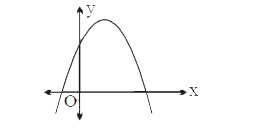यदि (a+b+c)>0 एवं a<0<b<c है, तो समीकरण a(x−b)(x−c)+b(x−a)(x−b)=0 के
वास्तविक तथा भिन्न-भिन्न मूल है।
मूल काल्पनिक है।
मूलों का गुणफल ऋणात्मक है।
मूलों का गुणफल धनात्मक है।
The correct Answer is:A, C
Step by step video, text & image solution for यदि (a + b + c) gt 0 एवं a lt 0 lt b lt c है, तो समीकरण a ( x - b) ( x - c) + b (x - a) ( x - b) = 0 के by Maths experts to help you in doubts & scoring excellent marks in Class 12 exams.
Updated on:21/07/2023Topper's Solved these Questions
- QUADRATIC EQUATIONBOOK - BANSAL HINDICHAPTER - QUADRATIC EQUATIONEXERCISE - Exercise - 1 [Special Dpp 2 ]
10 Videos
- QUADRATIC EQUATIONBOOK - BANSAL HINDICHAPTER - QUADRATIC EQUATIONEXERCISE - Exercise - 1 [Special Dpp 3]
10 Videos
- PROBABILITYBOOK - BANSAL HINDICHAPTER - PROBABILITYEXERCISE - EXERCISE-5 (RANK BOOSTER)
11 Videos
- RELATION & FUNCTION BOOK - BANSAL HINDICHAPTER - RELATION & FUNCTION EXERCISE - EXERCISE - 5 (Rank Booster)
16 Videos
Similar Questions
एक द्विघात बहुपद y=px2−qx+r का आरेख संलग्न चित्रानुसार है, तो

View Solutionएक द्विघातीय त्रिपद P(x) इस प्रकार है कि P(x)=0 एवं P(P(Px)) = 0 का एक उभयनिष्ठ मूल है , तो
View Solution4 स्वतन्त्र प्रयासों पर विचार कीजिए जिनमें एक एक घटना A के घटित होने की प्रायिकता 13 है। यदि घटना A कम से कम दो बार घटित होती है तो घटना B के घटित होने की प्रायिकता 1 है। यदि घटना A घटित नहीं हो तो घटना Bघटित नहीं हो सकती है। यदि घटना Aएक बार घटित होती है तो B की घटित होने की प्रायिकता 12है। यदि घटना B के घटित होने की प्रायिकता P को mn के रूप में व्यक्त किया जा सके, तो (m +n) का न्यूनतम मान ज्ञात कीजिये,जहाँ m, n∈ N है।
View Solutionनिम्न फलनों के प्रान्त व परिसर ज्ञात कीजिये।
y=log√5(√2(sinx−cosx)+3)
View SolutionFigure 2.23 shows the graph of the polynomial f(x)=ax2+bx+c for which (FIGURE) (a) a⟨0, b⟩0 and c>0 (b) a<0,b<0andc>0 (c) a<0, b<0 and c<0 (d) a>0, b>0 and c<0
View SolutionIf (a+b+c)>0 and a < 0 < b < c, then the equation a(x-b)(x-c)+b(x-c)(x-a)+c(x-a)(x-c)=0 has (i) roots are real and distinct (ii) roots are imaginary (iii) product of roots are negative (iv) product of roots are positive
View SolutionIf f(x)=x(1−logx), where x>0, show that (a−b)logc=b(1−logb)−a(1−loga), where 0<a<c<b
View SolutionIf a<b<c<d then show that (x−a)(x−c)+3(x−b)(x−d)=0 has real and distinct roots.
View Solutionयदि α और β(α<β), समीकरण x2+bx+c=0 के मूल है, जहाँ c<0<b, तब
View Solutionयदि a,b,c∈Q तो समीकरण (b+c−2a)x2+(c+a−2b)x+(a+b−2c)=0 के मूल है
View SolutionIf a<b<c<d, then the eqution 3(x−a)(x−c)+5(x−b)(x−d)=0 has
View SolutionIf 0<a<c,0<b<c then ∫∞0ax−bxcxdx=
View SolutionIf ∣∣ax2+bx+c∣∣≤1 for all x in [0, 1], then
a.|a|≤8
b. |b|>8
c. |c|≤1
d. |a|+|b|+|c|=19
View SolutionFigure 2.23 shows the graph of the polynomial f(x)=ax2+bx+c for which (FIGURE) (a) a⟨0, b⟩0 and c>0 (b) a<0,b<0andc>0 (c) a<0, b<0 and c<0 (d) a>0, b>0 and c<0
View Solutionयदि a<b<c<d, तब समीकरण
(x−a)(x−c)+2(x−b)(x−d)=0 के मूल होंगे
View Solution
